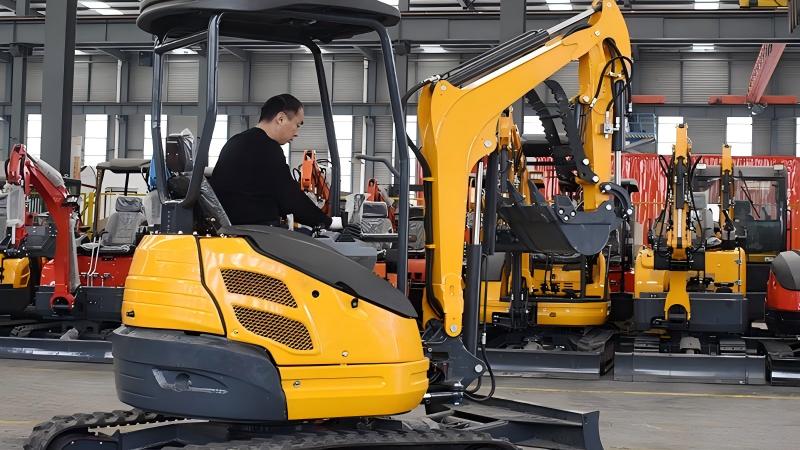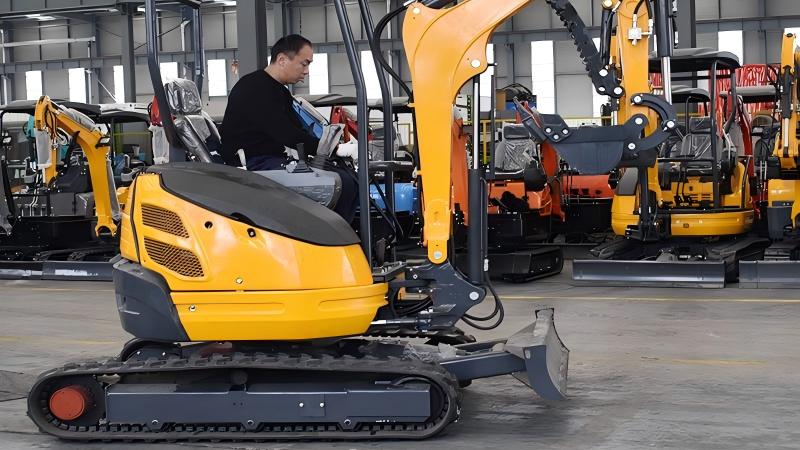The Appeal of Mini Excavators
Before delving into the ease of learning, it's worth understanding why mini excavators are so popular:
Compact Size: They can fit into tight spaces, navigate residential yards, and work in areas inaccessible to larger machinery.
Versatility: With a variety of attachments (buckets, augers, breakers, thumbs), they can perform digging, trenching, grading, demolition, and material handling.
Reduced Impact: Their lighter weight and rubber tracks (common on minis) minimize ground disturbance, which is crucial for sensitive sites or finished landscapes.
Cost-Effectiveness: Renting a mini excavator is often more economical for smaller projects than hiring a full-sized machine and operator.
Why Mini Excavators Are Relatively Easy to Learn
Several design features and operational characteristics contribute to the user-friendliness of mini excavators:
1. Intuitive Controls
Modern mini excavators typically use a standardized control pattern, most commonly the ISO (International Standards Organization) pattern, also known as the "excavator control" or "John Deere pattern." Some older or less common machines might use the SAE (Society of Automotive Engineers) pattern, or a "backhoe control." However, many modern machines offer a pattern changer switch, allowing the operator to select their preferred configuration.
Two Joysticks (Pilot Controls): The primary controls are typically two hydraulic joysticks that govern the boom, stick (dipper), bucket, and swing functions.
Left Joystick: Often controls the swing (rotation of the house) and the stick (in/out).
Right Joystick: Often controls the boom (up/down) and the bucket (curl in/out).
Foot Pedals/Levers: Used for tracking (moving the machine forward and backward) and sometimes for auxiliary hydraulics (for attachments).
Simplicity Compared to Older Machines: Gone are the days of multiple, confusing levers. The joystick controls are highly intuitive for anyone familiar with video games or modern machinery, making the learning curve much smoother.
Proportional Controls: Many mini excavators feature proportional hydraulic controls, meaning the speed and force of the movement are directly proportional to how far you push the joystick. This allows for very precise and smooth operations, reducing jerky movements that can make learning difficult.
Slower Speeds and Reduced Power (Relative to Larger Machines)
While powerful for their size, mini excavators operate at slower speeds and have less raw power than their full-sized counterparts. This is a significant advantage for beginners:
More Forgiving: Slower movements give new operators more time to react and correct errors. There's less risk of sudden, uncontrolled movements.
Reduced Overwhelm: The lower power output means that while they can still accomplish substantial work, they are less likely to cause significant damage through accidental over-extension or aggressive digging.
Excellent Visibility
Operator stations in mini excavators are designed to provide excellent visibility of the work area, the tracks, and the immediate surroundings.
Compact Size: Being smaller, there's less machine mass obstructing the view.
Glass Cabins: Many models feature spacious cabs with large windows, reducing blind spots.
Open Stations: For simpler models, an open canopy offers unobstructed 360-degree views.
Ergonomics: Controls are typically well-placed and adjustable, allowing operators to maintain comfortable posture and focus on the task.
Safety Features
Modern mini excavators are equipped with numerous safety features that protect both the operator and the machine:
ROPS/FOPS Cabs: Roll-Over Protective Structures and Falling Object Protective Structures provide crucial protection in case of tip-over or falling debris.
Seat Belts: Essential for keeping the operator securely in place.
Safety Levers/Lockouts: These prevent accidental operation of hydraulic functions when the operator is not seated or when a safety bar is not lowered.
Audible Alarms: Reverse alarms and swing alarms alert workers nearby.
Emergency Stop Buttons: Allow for immediate shutdown in critical situations.
These features build confidence in new operators by providing a safer learning environment.
The Learning Process: What to Expect
While mini excavators are relatively easy to learn, they are still powerful pieces of machinery that require respect and proper training. Here's a typical learning progression:
Familiarization with Controls (The "Dry Run")
Before starting the engine: Sit in the operator's seat. Identify every lever, button, and pedal. Understand its function.
Pattern Identification: Determine if the machine uses ISO or SAE controls, and if there's a pattern changer.
Engine Start/Stop Procedure: Learn the correct sequence.
Safety Features: Locate and understand the safety lever/lockout, emergency stop, and seatbelt.
Basic Machine Movement (Tracking)
Open, Flat Area: Start in a large, open, and level area free of obstacles.
Slow and Steady: Practice moving forward, backward, turning, and pivoting using the track controls. This takes coordination.
Head in the Direction of Travel: Remember to orient yourself with the tracks. When turning the superstructure, the track controls may effectively reverse their function relative to your body.
Mastering Boom, Stick, and Bucket Functions
Individual Movements: Practice moving the boom up and down, extending and retracting the stick, and curling the bucket in and out, one function at a time. Focus on smoothness.
Combined Movements: This is where the skill truly develops. Practice combining functions, such as raising the boom while simultaneously extending the stick and curling the bucket to dig efficiently. This requires coordination between both hands and often feet for tracking.
Digging a Simple Trench: Start with a basic task like digging a straight, shallow trench. Focus on maintaining a consistent depth and width.
Spoil Pile Management: Learn to swing the excavated material and deposit it neatly into a spoil pile.
Safety and Site Awareness
Always Look Around: Constantly scan your surroundings for people, obstacles, and utility lines (overhead and underground).
Understand Load Limits: Never exceed the machine's lifting capacity.
Stabilization: Learn how to use the blade (dozer blade) for stability during digging and for light grading.
Ground Conditions: Be aware of soft ground, slopes, and unstable terrain.
Who Can Operate a Mini Excavator?
Technically, many places do not require a specific license to operate a mini excavator on private property. However, for commercial work or on public job sites, certifications (like OSHA in the U.S.) are often mandatory. Even for personal use, it is highly recommended to:
Read the Operator's Manual: This is your primary source of information for that specific machine.
Watch Instructional Videos: Numerous online tutorials demonstrate proper operation.
Seek Professional Training: If possible, consider taking a short course or hiring an experienced operator for a few hours of one-on-one instruction. This is invaluable for building confidence and learning best practices.
Start Small: Begin with simple, non-critical tasks in a controlled environment. Don't jump straight into complex or dangerous jobs.
Common Challenges for Beginners
While learning is relatively easy, new operators might encounter some challenges:
Coordination: Mastering the simultaneous use of joysticks and foot pedals takes practice.
Spatial Awareness: Judging distances and the precise position of the bucket can be tricky initially.
Over-Digging/Under-Digging: Achieving consistent depth requires a feel for the machine.
Patience: Rushing the learning process can lead to mistakes and frustration. Take your time.
Fatigue: Operating heavy machinery, even small ones, can be physically and mentally tiring. Take breaks.
Conclusion
Are mini excavators easy to learn to operate? The answer is a resounding yes, relatively speaking. Their intuitive controls, slower operating speeds, excellent visibility, and robust safety features make them far more accessible than one might initially assume. While they require practice, patience, and a strong commitment to safety, many individuals, from DIY enthusiasts to aspiring contractors, can quickly gain proficiency. With proper training, adherence to safety protocols, and a willingness to learn, you can confidently and effectively tackle a wide array of projects with a mini excavator.
Post time:Sep-25-2020



